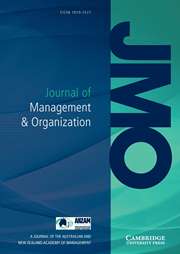Article contents
CEO overconfidence and firm performance: A meta-analytic review and future research agenda
Published online by Cambridge University Press: 09 November 2023
Abstract
We provide a meta-analytic examination of the CEO overconfidence–firm performance relationship. Our results support a positive relationship between these focal variables. Drawing from trait activation theory and national cultural differences literatures, we find that cross-cultural effects moderate the focal relationship. More specifically, we find that the CEO overconfidence–firm performance relationship is stronger in high assertive, low institutional collectivistic, low in-group collectivistic, high future-oriented, high gender egalitarian, high performance-oriented, low power distance, and low uncertainty avoidance cultures. Consistent with the resource orchestration literature, we also find that entrepreneurial orientation mediates the focal relationship between CEO overconfidence and firm performance. Taken together, our results present a more nuanced picture of the CEO trait–firm performance relationship. In the future, researchers may consider examining additional CEO traits as well as additional contextual factors including internal, as well as environmental, factors.
Information
- Type
- Research Article
- Information
- Copyright
- © The Author(s), 2023. Published by Cambridge University Press in association with the Australian and New Zealand Academy of Management
Footnotes
Chao Miao is the first author and corresponding author.
Joseph E. Coombs and Shanshan Qian are second authors and they equally contributed to this paper.
References
- 6
- Cited by

